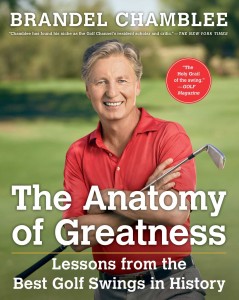The Anatomy of Greatness: Lessons from the Best Golf Swings in History
What are the fundamentals of a good golf swing?
Can most players learn them, or are the great golfers great because they can do something the rest of us can’t?
Brandel Chamblee believes he is up to the task of answering these and related questions, in his new book.
The former PGA Tour golfer and current Golf Channel analyst pored over hundreds if not thousands of photographs of some of the well-recognized greats of the game, looking for commonalities that could explain why they were so good at hitting a small ball so well. As he shows, the rest of us are also capable of learning those same effective techniques.
From close observation of Chamblee’s commentary during many hours of Golf Channel viewing, it’s fair to say that he doesn’t suffer from excessive humility. On the other hand, when you can back up what you say with statistics or cogent analysis, as he usually does, a little pride in your work doesn’t do any long-lasting harm.
At times the book read a little bit like golf’s version of a Zapruder film analysis, but I give Chamblee credit for the effort. Now that’s he’s done it, you have to wonder why so many others writing about the basics of the golf swing didn’t take the same approach.
Chamblee’s most effective quote from others, it seems to me, came from Bobby Jones: “In examining and comparing the methods of various players it is always necessary to be aware of the difference between mannerisms and fundamentals.”
For example, Phil Mickelson and John Daly, among many others, take their drivers well past parallel on the backswing.
That’s a mannerism.
From there, both Mickelson and Daly, among many others, bring their drivers to impact with the ball with a high degree of repeatable quality.
That’s a fundamental.
The book’s structure follows the elements of a golf swing, beginning with the grip, setup, and posture, and on through the impact and finish. In this respect Chamblee follows in the footsteps of past writers about the golf swing, from Ben Hogan’s Five Lessons through Steve Elkington’s Five Fundamentals. This arrangement should be especially helpful to beginning golfers.
Chamblee’s analysis focuses on several golfers from golf’s golden age: Ben Hogan, Byron Nelson, Mickey Wright, Jack Nicklaus, and Sam Snead among them. He also credits Tiger Woods (from earlier in his career) with adhering to the common swing elements Chamblee describes.
By identifying and eliminating the mannerisms, Chamblee discerns what really went on in the swings of the past greats of golf. After all, if it worked well for them, it should work well for everybody–a perfectly logical conclusion.
Chamblee also pointedly disagrees with what he argues are the major flaws in current golf instruction, which don’t follow these same fundamentals.
For example, Chamblee sees the raised left heel in the backswing as essential, with photographic evidence to support him. Therefore, he sees no benefit and some risk of injury for those golfers who follow instruction to keep the left foot flat in the drive, as a critical component of the “modern” swing.
Chamblee also takes a very dim view of teaching golfers to restrict the hip turn during the backswing, suggesting nothing but nagging injuries will eventually result.
From the steady reports of back problems among the current crop of PGA stars, it seems that Chamblee has a point, and not just from his photo-analyses of Snead, Lee Trevino, or Nicklaus.
The more senior golfers among us can also take heart from the fact that if Chamblee’s right, we shouldn’t try to imitate a Millennial disciple of the modern swing–and we don’t have to, either.
Chamblee’s short, quick-reading study presents a convincing argument that what worked well in the past should work well now, and in the future.
Changes and improvements in golf ball design and club technology are to be expected. Nonetheless, the elements of the golf swing are essentially timeless, and tinkering with those parts does no one any good.
Review Date: May 4, 2016


